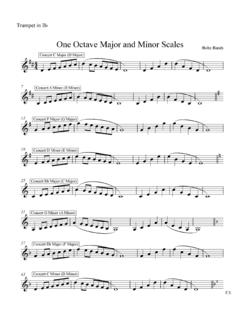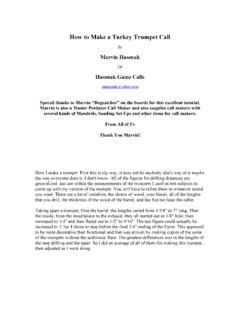Transcription of Dear Trumpet Teacher, I hope you enjoy this free …
1 Dear Trumpet teacher , I hope you enjoy this free sample of Sound Habits Brass Builder for Trumpet . Included you will find some of the introductory text, the table of contents, instructions for the first series of exercises, and music for series four. You should find enough here to give you a good idea of my teaching philosophy and the opportunity to try it out. The accompaniment CD is an integral part of this method book. The Trumpet CD features examples of buzzing and playing by James Thompson. Instructions are provided on the CD so that on the first day with their instrument, students can turn it on, open their book, and play. You can sound file examples on our web site at After just a few weeks of use you will discover that your young musicians will be listening critically and improving their tone, pitch and rhythm accuracy. Happy trumpeting!
2 Rob Sayer SOUNDHABITS Brass Builder for TrumpetRobert Sound Habits Brass Builder for TrumpetDeveloped by Robert Sayer for The Music Class, Inc. 770-645-5578 Email: Copyright 2012 Robert Sayer. Made in USA. All Rights Reserved. Unauthorized duplication is a violation of applicable laws. Cover Illustration: Lindsay TaylorSOUND HABITS Brass Builder for TrumpetBy Robert SayerWith this ten-minutes-a-day, fun-to-play method, beginning students will: 5Y\^[bQ `TQU^ \U`OT MOOa^MOe 1_`MNXU_T M O[^^QO` QYN[aOTa^Q 0 QbQX[\ M RaXX \XQM_MZ` `[ZQ ]aMXU`e When learning to play the Trumpet , what could be more importantthan listening to a great Trumpet player? The enclosed CDs feature James Thompson s Trumpet playing to imitate!The author:Robert Sayer is a music educator specializing in early childhood music development and beginning instrumental instruction.]]]]
3 He has a master s degree from the Manhat-tan School of Music and has studied Trumpet with Edward Treutel, Allan Dean, William Vacchiano, Arnold Jacobs, and James Thompson. Robert was a school band director for many years before founding The Music Class, Inc., an international early childhood music education recording artist:Recording by James Thompson, professor of Trumpet at the Eastman School of Music. Former Principal Trumpet with the Atlanta Symphony Orchestra and the Montreal Sym-phony project manager:Elizabeth Meeker is a freelance trumpeter and music instructor in San Diego. She has a bachelor s degree from Boston University and a master s degree from Yale University. She is a member of the faculty at Southwestern book s name:Daily Play-Along Brass Builder was the original name of the Trumpet version of this book. With the new 2012 edition we felt a simpler name was in order, so we updated the name to be part of our Sound Habits series.
4 Other Sound Habits materials published by The Music Class include Sound Habits: Learning to read Music and Sound Habits: Keyboard Class Table of ContentsIntroduction for the teacher ..1 The Buzz - A note for teachers ..2 Mouthpiece Up! ..4 Your cheeks, Dizzy s cheeks ..5 What should the inside of your mouth feel like when you play? ..6Ha - Ta- Trumpet ! ..7 The Big Breath ..8 With the CDSeries 1 ..10 Buzz Rock, Buzzing the Blues, Buzz on DownSeries 2 ..11 Going Up, Going Down, Down/UpSeries 3 ..13Up/Down, Up and Up, Down and Down Series 4 ..14 America, Exercise 1, Old MacDonald, When the Saints Go Marching InSeries 5 ..16 Alma Mater, Exercise 2, Simple Gifts, This Old ManSeries 6 ..18 Exercise 3, On Top of Old Smokey, C Major, A Minor, Pop Goes the Weasel, Long Long AgoSeries 7 ..20 Exercise 4, Motherless Child, D Major, B Minor, Row Row Row Your Boat, MinuetSeries 8.
5 22 Exercise 5, All the Pretty Little Horses, Eb Major, C Minor, The Animal Fair, Erie Canal 1 Introduction For The teacher This book and tape were designed to be a helpful supplement to traditional beginning brass books. With regular practice, these materials will help to improve the pitch accuracy, tone quality and embouchure of the beginning brass player. The lessons are designed to take about ten minutes each. They are short enough for students to stay focused, and they leave you time to teach your regular material afterwards. The book can be used for private lessons or group brass classes. The companion books are designed to be used together, in any combination desired. The soundtrack was composed to appeal to today's students, establish good musical habits, and make class fun. Best of all, you will discover rapid progress among your students as they play exercises and music that they enjoy !
6 IMPROVING PITCH ACCURACY Tired of Trumpet players pushing the right valves but guessing what partial to play? You will find this book a fun and simple way to improve the pitch accuracy of your Trumpet players. Because the first three series do not use written music, students naturally focus on the pitch of the performance they need to imitate. This type of practice encourages each student to develop a critical listening habit. By playing on the mouthpiece without note reading or fingering distractions, students discover what needs to be done to match pitches on the mouthpiece. In series two they are starting to transfer that skill to the Trumpet . When written music is used in series four through eight, the students are always asked to listen first and then buzz the song before playing it on the Trumpet . This forces them to use their ears, audiate, and then go for the right note.
7 IMPROVING TONE QUALITY We know that when a student is able to audiate a good model of sound in his ear, he is more likely to succeed at reproducing that sound on his or her instrument. The echo format of this tape provides outstanding examples of Trumpet playing on almost every exercise and song. For many students, excessive tension occurs when they see a high note. This tension constricts the air flow and results in decreased range and diminished tone quality. On the other hand, students who play more by ear tend to stay more relaxed. They have greater ease in their high register, and due to the relaxed state of the body, have a better tone quality. This book helps the beginning Trumpet player to develop the habit of focusing on the sound he/she desires to produce. Due to the absence of music in the first three series, students are not aware of how high they are being asked to play.
8 They simply focus on sound. This keeps the body relaxed and improves the tone. ESTABLISHING A CORRECT EMBOUCHURE The text at the beginning of this book will help guide students away from many of the most common mistakes beginning Trumpet players make. Once a habit is formed it is very difficult to change. Students should study pages 4 - 8 of this book during their very first week of playing and then review frequently as they move on. This will help to establish as many correct habits as possible. 2 THE BUZZ - A Note for Teachers By buzzing from the very beginning, young Trumpet players will establish correct aural/oral thought habits. While using this tape, students will need to listen first (aural) and then produce sound on the mouthpiece (oral) without the assistance of the Trumpet . The sequence of hearing a pitch in your mind and then getting the lips to produce that pitch is the essence of brass playing.
9 In fact, music is an aural/oral tradition. It's very important to develop a habit of aural/oral thinking at the very beginning. Students who are first taught the analytical process of reading music and determining the correct valve combinations tend to count on the Trumpet to produce the right sound. Frequently these students need to spend many years trying to readjust their thinking habits from an analytical style to the more musical aural/oral style when they become older. WHILE BUZZING, THE LIPS NEED TO BE RELAXED, NOT TENSE. The mouthpiece has less resistance than the Trumpet . Therefore, by playing the mouthpiece alone the player will get used to flowing more air through the instrument. As you practice on the mouthpiece the less resistance tends to let the lips relax and buzz more freely into the mouthpiece. Analyze the sound of the mouthpiece buzz.
10 As the lips become less tense the tone from the mouthpiece will become fuller, with more overtones sounding. Of course, the same benefit will be heard on the Trumpet . ONE EMBOUCHURE We want to be able to set one embouchure to play over the whole range of the instrument. Most brass players will have one embouchure setting for their middle range and then make adjustments to their embouchure when they go into their high range or low range. With beginners, these adjustments can be dramatic and may include pivoting, changing the amount of lip in the mouthpiece, excessive muscle fluctuation around the embouchure, or even muscle tension around the entire face. With advanced players, adjustment to the embouchure also takes place, but usually in a very small manner. Nonetheless, even minute changes create differences in tone quality in the different ranges of the instrument.






